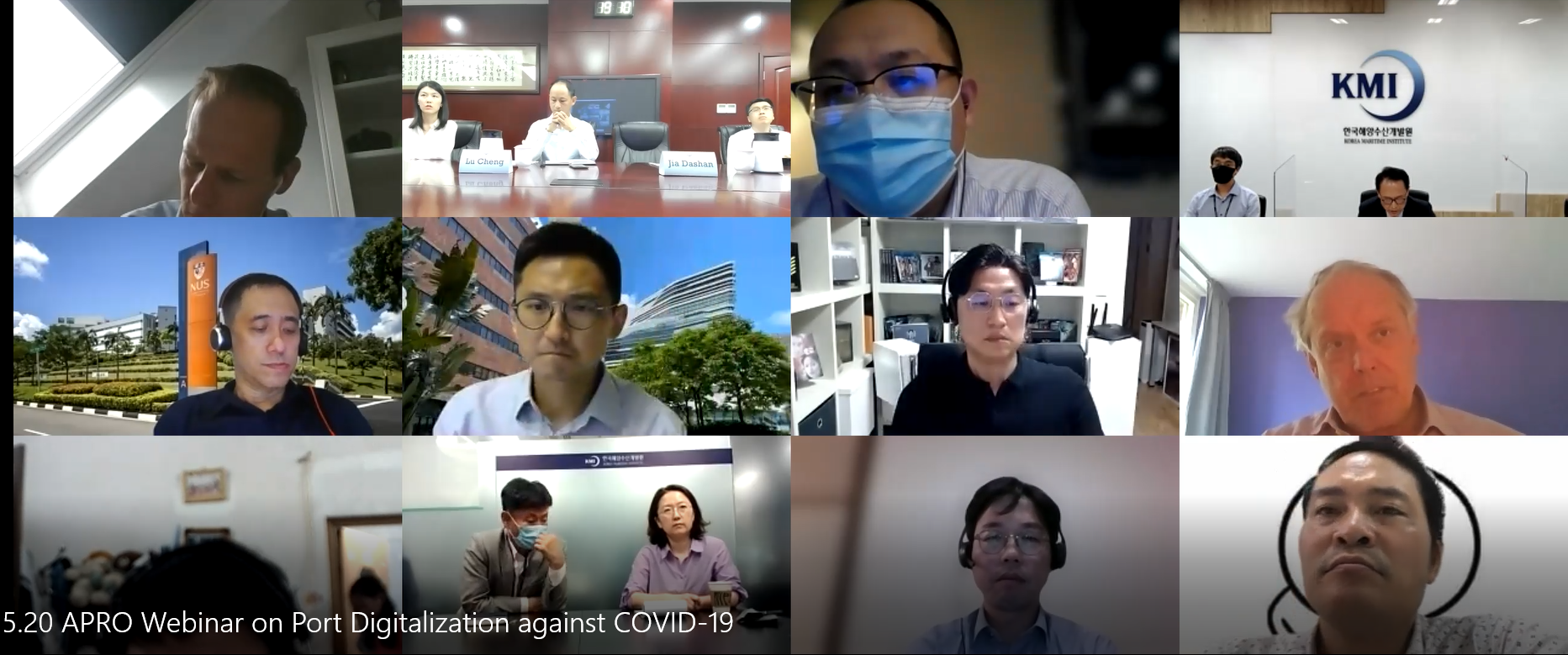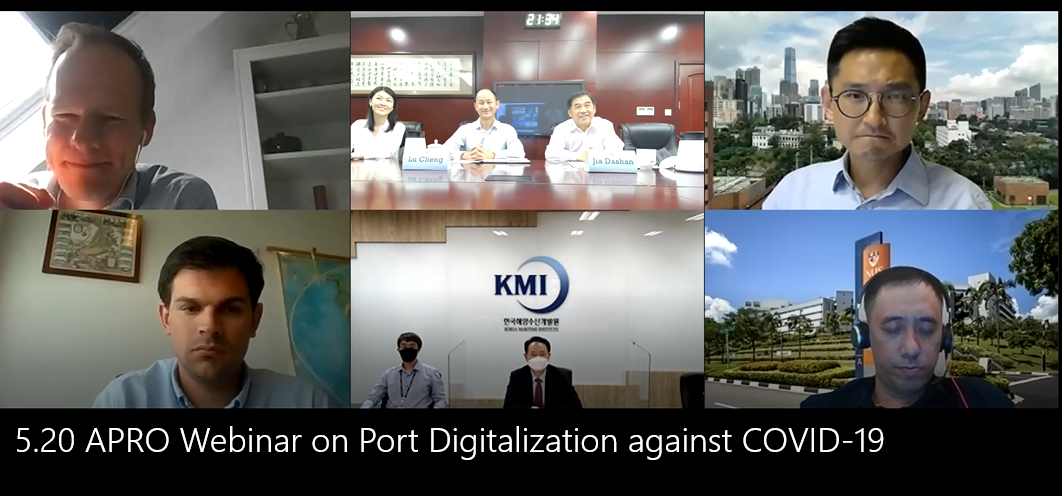Report of APRO Webinar
on
Port Digitalization against COVID-19 Pandemic
APEC Port Study Center
June 2021


1. Introduction
The first APEC Port Research Collaboration Platform (APRO) webinar was held on May 21st, 2021 at 7:00pm Beijing/Singapore time. Six speakers were invited to deliver presentations. The participants are from Canada, China, Hong Kong China, Indonesia, Japan, Korea, Malaysia, the Netherlands, the Philippines, Papua New Guinea, Singapore, Thailand, United States and Vietnam. Participants from international organizations including UN-ESCAP and IPCSA also joined in this Webinar.
1.1 Opening Remarks
The President of Korea Maritime Institute and the Chair of APRO, Dr. Young-Tae Chang delivered an opening remarks and welcomed every participants of the webinar, in particular the five founding members of the APRO, namely Center for Maritime Studies (CMS), National University of Singapore (NUS); the Center for Transportation Studies (CTS), University of British Columbia; Korea Maritime Institute (KMI); Shipping Research Center (SRC), the Hong Kong Polytechnic University (PolyU); and China Waterborne Transport Research Institute (WTI). Dr. Chang introduced the history and establishment of APRO and emphasized that the international cooperation at this moment is critical for maritime community, thus the establishment of APRO is important to better serve the industry.
1.2 Introduction of the Webinar
Mr. Lu Cheng, the Director of APEC Port Study Center, briefly introduced the webinar. He also stressed that as a loose and voluntary mechanism, the APRO will promote the information exchange and encourage discussions on the trending topics of the port industry.
2. Experts Sharing
Six experts in the maritime industry gave their presentations on the theme of port digitalization against the COVID-19 pandemic respectively. The presenters are Mr. Richard van Liere and Mr. Manuel Martinez de Ubago Alvarez de Sotomayor from STC-NESTRA, Dr. Kiyoul Lee from KMI, Mr. Geng Xiongfei from WTI, Dr. Lee Loo Hay from CMS, NUS, and Dr. Yang Dong from SRC, PolyU.
2.1 The Impact of COVID-19 on Port Digitalization by STC-NESTRA
2.1.1 Introduction and Study Objectives
The COVID-19 has resulted in a global pandemic and resiliency issues in ports have become prominent as a result of the pandemic. Digitalization is on the top agenda in the industry to increase resiliency. The research goal is to study whether COVID-19 has accelerated or not digitalization of ports, and what lessons can be learned, what the bottlenecks are and what recommendations can be proposed for the APEC region. This study is also a follow up action conducted by APSN Secretariat and APEC Port Study Center in response of the request of APSN Council during the 2020 APSN Council Extraordinary Meeting.
2.1.2 Understanding Port Digitalization
The port digitalization, according to STC-NESTRA, lacks internationally accepted definitions and scope. Thus, STC-NESTRA defines the term “port digitalization” as technology-based solutions to solve complex problems.
2.1.3 Online Survey
The online survey is set up in the study. The respondents are divided into different groups and asked the level of maturity (LoM) of trade facilitation tools within their ports before the pandemic. The survey characterized the answers into four different scales (In existent initiative, planned to develop, developing phase, fully developed and rolled out). In each of the tools, the respondents are asked to what extent their ports have been adopted.
The result indicates that, overall, higher degree of maturity of the maritime single window (MSW) than port community system (PCS) (in line with literature). All respondents reported that MSWs are at least in planning phase. For PCS, mode falls in planning phase.
2.1.4 Status of port digitalization before and after COVID-19
When measuring the port digitalization after the COVID-19, the respondents were asked, in addition to the degree of maturity, whether the LoM have been accelerated after the COVID. The result shows that no incremental steps in comparison with pre-COVID. Yet, 50% reported that COVID did accelerate its implementation. This gap explains that developing PCS or MSW can take times for several years.
On other tools such as port management information system (PMIS), terminal operating system (TOS) etc., most initiatives/tools were proposed before COVID-19. Yet, their implementation seems to have accelerated as a result of COVID-19.
As a result from the survey, the topic of port digitalization has increased significantly across management position levels at discussion level. But at implementation level, concrete plans has been conducted at various degrees. Some front runners were already digitally mature. But the bottlenecks hinder digitalization efforts in other (smaller) ports.
2.1.5 International practices in port digitalization
Case 1: Port of Xiamen adopted the centralized approach towards world-class ports and intelligent shipping. The large range of technological solutions includes intelligent tally systems, remote equipment control systems, smart logistics container platforms, etc.
Case 2: National Port Authority of Peru swift reaction by the government to facilitate trade during the pandemic (Decree 1492, Supreme Decree No. 008-2020-MINCETUR) to expand current MSW, including PCS functionalities.
Case 3: Port of Rotterdam adopted a stakeholder management approach. The port authority plays an active role with an entrepreneurial mindset towards the development of digital tools and the continuous learning process. The latest focus is on the development of the digital twin of the entire port.
2.1.6 Challenges and recommendations
The challenges mainly are the bottlenecks on implementing digitalization initiatives. Another survey is set up to ask what the specific challenges the respondents have encountered in their ports. Several domains of bottlenecks are specified in the survey.
(1) Political aspects include a high turnover of government representatives in the port sector, and therefore changing priorities. It also includes lack of capacity by the government bodies, in need of external assistance, and lack of alignments at regional level between cooperation frameworks and assistance bodies, but also at economy/provincial level.
(2) Economic aspect is on budget restrictions by stakeholders, worsened by COVID-19. Economic evaluation should not only be considered comprehensively from a sustainability perspective but also from social and environmental perspectives.
(3) On social and cultural aspects, the bottlenecks include lack of stakeholder management which delays implementation. Skepticism by port stakeholders towards collaboration and digital transformation in general can be another burden for some ports to change.
(4) On the technical aspect, the bottlenecks include quality and availability of data, lack of ICT infrastructure, cyber security, lack of qualified workforce, and integration of several different systems (interoperability).
(5) On legal aspect, if an economy does not have a sound and adequate legal and regulatory basis, it is difficult to adopt digital transformation.
In summary, the study offered recommendations to the port community. First, the port should run a digital audit to examine not only in technological aspect but also other elements (e.g., organization culture, governance...) and considering the wider port community level. The audit is important to bring organizations and departments together and help the port design a longer-term strategic plan.
The second recommendation is that a collaborative environment should be promoted. At the port level, the port should be encouraged to embrace a culture of proximity with the department and share knowledge and findings on (smart) business case ideas. At the economy level, collaboration should be promoted with and within different international bodies so that more synergies can be achieved.
Third, at the management level, engagement is the key. Continuous education is important. The Port community should better understand the potential benefits and challenges of digitalization. At the operational levels, the workforce will have to become increasingly familiar with new tools.
Last, promoting innovative ecosystem around the port is important for the technological innovation.
2.2 The Impact of COVID-19 on Port Volume in Korea by KMI
2.2.1 Introduction to PDAC
The Port Demand Analysis Center (PDAC) was established in July 2006 aiming to support port development in the context of changes in port logistics environments in domestic and overseas. PDAC is also responsible for support port policy development such as exploring port-related major agendas and for predicting port volume from mid- and long-term perspectives.
2.2.2 Impact of COVID-19 on Port Volume
According to Drewry’s study, port container volume worldwide down by 2.1% from the previous year. Total domestic port volume down by 8.8% and container volume in 2020 down by 0.5% from the previous year.
Based on the current situation, the container volume has successfully navigated through the COVID disruptions. The automobiles have decreased in export volume from major exporting economies due to the pandemic. The iron and steel volume has also decreased due to shrunk demand from related industries. The liquid bulk has reduced global demand for petrochemicals and a significant decrease in export volume due to a drop in the unit price.
2.2.3 Intelligent Port Demand Prediction System
The disruption caused by COVID-19 requires an in-depth analysis of port demand and the development of a model platform for high-precision demand prediction. The Intelligent Port Demand Prediction System has been established based on big data. The system will enhance the reliability of predictions for mid- and long-term port volume and supply and demand.
2.3 Research on Port Cyber Physical System Research by WTI
2.3.1 Shipping in the Intelligent Age
Mr. Geng introduced three different spaces the shipping industry can go into: physical space, social space, and cyber space. The shipping industry has been evolving through different ages. Traditional shipping is only limited to the natural space. After years of development, the shipping industry has entered the social space. In the Digital Age, the shipping industry has entered the third space, which is cyber space. The so-called intelligent shipping can go into all three different spaces. The ports, ships and support facilities are included in intelligent shipping and entered three different spaces.
However, intelligent shipping in cyber space can not only be achieved by the shipping industry alone. The rapid development of AI and other modern technologies has provided the technical foundation for intelligent shipping and reduced the costs of technological innovation in the shipping industry.
2.3.2 Cyber Physical Model of Mega Port
How to build cyber physical model for the mega port? The cyber physical model has consisted of four layers: (1)Physical layer--staff, equipment, cargo, and environment; (2)Data link layer--Public communication network, industrial internet network, satellite internet network; (3)Mathematical expression layer--Material movement control model, security emergency scheduling model; (4)Application layer--Intelligent production organization, analysis of port operation, emergency management, equipment operation decision, and business operation forecasting.
Five standards are included in the cyber physical model of mega port: (1) standard of port production factors digital definition; (2) standard of port model (3) standard of port data link networks (4) standard of port CPS system construction and (5) standard of port digital level evaluation.
2.3.3 Ubiquitous Sensing Networks of Port
Two parts have been developed for port ubiquitous sensing network solution. The first is data transmission requirement. The second part is method of network construction. How to use the frequency allocation method of 5G network? For the high-frequency, large uplink is used. For the mid-frequency, large downlink is used. For low-frequency, large coverage is used (30-50 nm A1 area coverage).
2.3.4 Future Research Plan
The future research plan is on digital port and autonomous ship. On the digital port, the research is specialized in berthing, pilotage, towboat, port handling and safety supervision. On the autonomous ship, the research is on sensor, communications and control.
For example, BRINAV Autonomous Ship is a fully automated container ship with a capacity of around 300TEU. This ship is currently being built in Qingdao. In late this year, BRINAV will be put into operation. This project will be initiated in late 2021 and completed in 2023.
2.4 Development of Digital Twin for Next Generation Container Port by NUS
2.4.1 Background Introduction
Singapore government has developed a “Sea Transport Industry Transformation Map” for the industry, which emphasizes the aspects of innovation, productivity, jobs & skills, and internationalization. In terms of innovation, it refers to the next generation port services harnessing the potential of digital technologies. Digitalization has become one of the key initiatives in the maritime industry right now.
Singapore is building a mega-port called Tuas Port. This container port is different from the traditional port in the aspect that all the port activities are going to concentrate in one location. The Center of Excellence in Modeling and Simulation for Next Generation Port (C4NGP) of NUS helps the mega port develop different systems to optimize the port. Operating such a mega port in a fully automated way is a challenge for the port design. The problem is how the port activities can be managed in such a complicated and more efficient way.
2.4.2 Main Idea of the Digital Twin
Industry 4.0 is different from the past industry revolution in which it emphasizes cyber-physical systems, the internet of things, and networks. The main idea of the digital twin is how to manifest the physical system in a digital world. However, one of the interesting questions is that whether single digital twin or multiple digital twins are needed. Since ports are purpose-driven, when mentioned digital twin, it often refers to multiple digital twins in the digital world.
2.4.3 How Digital Twin Work
When a digital twin get the information from the real system, after being executed and running the simulation, it advises how the actual system should operate. Usually, the control system is lagged behind with the changes. However, with the digital twin, it can predict the potential risks and disruptions even before these changes happen. The digital twin is better than the data in a way that it could let the control system not only learn from the current, but also from the future.
Once the port has the historical data, real-time (IoT) data, the digital twin can predict all the future scenarios and produce the future optimized data from times of training, predicting, and preparing. All the data added can create augmented intelligence so as to create the super brain. The super brain can advise the digital twin and also advise the physical system. The digital twin can not only tell what happened currently but also look at the potential future and accordingly make the decision.
2.4.4. How Digital Twin Help
The digital twin can help design the system, and do some testing such as ‘Plug and Play’ between the digital twin and the physical system. It can also help to test the scenario and predict the response of the potential disruptions.
The “Smart Digital Twin” concept involves four different dimensions-Visualization, Connectivity, Analyzability and Granularity. Traditionally, when mentioned digital twin, people usually think about the first two aspects. However, the other two dimensions decide how digital twin smart enough. Analyzability means that the data from outside sources can be learned and analyzed. Granularity means that the digital twin should not have only a single model, but different models, different fidelity to achieve the objectives.
2.4.5 Analyzability--Digital Twin Enable Data Analytics
The digital twin enables data analytics. With the simulation, optimization, and digital twin, future data is available to create. The digital twin can generate different scenarios for the future from which people can learn. By using simulation and optimization, a more optimal decision can be generated. In summary, the digital twin is not only a 3D model. Depending on the purpose, the digital twin will combine the “right” modules to create models to answer the questions.
2.4.6 Development of Digital Twin in NUS Center
NUS Center develops O2DES.NET Framework which includes three components. The first component is the embed optimization inside the simulation. The second is using the simulation under the optimization. Finally, the data can be obtained from the real-time data and simulation data and then proceed with the simulation analytics.
2.4.7 Digital Twin Applications
Digital twin can be applied in many aspects such as port design, port ML Studio (which let people create port simulation) yard planning, and AGV transport etc. One of the ideal goal is to build a digital twin for the maritime system, including the sea, the port and the land system. Finally, the digital twin will enable to plan and predict the future.
2.5 A Real-time Port Performance Monitoring System and Its Application by PolyU
2.5.1 A real-time port monitoring system
(1) Background and structure
Why developed a real-time port performance monitoring system? Maritime data is hard to obtain. In addition, the maritime statistics issued by the UN and other authoritative organizations are usually in low frequency, delayed, unavailable (i.e., pay fees) and insufficient. On these regard, a global port performance monitoring system is developed to break the data barriers and promote global port statistics standardization.
The structure of the system includes port productivity, port congestion, and port connectivity analysis, at least in high-frequency. The automatic berth and anchorage area should be identified accurately by the algorithm. It’s difficult to create the chart. First, all port dynamic area are created.
(2) Port congestion estimation
A dynamic algorithm is built up to identify the berth area and anchorage area for all the ports around the world. Then there are two conclusions. First, the ship densities are different in berth and anchorage areas. Second, the ship arrives at the anchorage first and then berth. Then, an iteration is set up to calculate the average congestion for the port. An average congestion ration has been created and the accuracy of the stats are confirmed by the ports.
(3) Port productivity and throughput forecasting
The efficiency of a port is usually calculated by the actual throughput (TEU) of the port during a certain time. The difficulty is to know how long a ship berths at the port. This problem can be solved by the AIS system. Two technologies have been used. One is the visualization technology and the other is big data analysis.
The process of berth time calculating goes through several steps. First, the berth area of each port is analyzed with satellite imagery data. Then an algorithm is developed with each ship calculating each ship berth at the ports. The port efficiency is obtained during COVID-19.
This is useful for the forecasting the future throughput. The productivity of ship of each port is known. A short-term productivity maintained the same is assumed. With the time of ships berth at each port, the throughput can be calculated, then compared with the real-time throughput. In port throughput estimation, the variable moving average (MA) is used to future productivity of port. The mean absolute percentage error (MAPE), also known as mean absolute percentage deviation (MAPD), is used to measure the prediction accuracy.
The throughputs of different ports including Shanghai, Singapore, Shenzhen, Ningbo-Zhoushan, Hong Kong, China, Busan, Los Angeles, Long Beach, New York-New Jersey, Yingkou have been estimated. Most of the errors are less than 5%, e.g., for Busan is less than 2%. Thus the estimation is quite precise.
(4) Port connectivity
The port connectivity is also calculated. However, the Industry index in most of the current literature mainly focuses on indicators related to port only. The academic papers discuss the network indicators, but difficult in calculation and only cover regions (due to data abundance). And some of the academic literature is usually published in low frequency and delayed.
To precisely estimate the port connectivity, the container port connectivity index system is developed which includes, not only port, but connected economies, network indicators (sources cited from AIS), strategic importance of the port in the world.
With this connectivity index system, some new discoveries are found. If measured by indicators only related to the port, the port of Antwerp is not ranked on top 20. Because if measures only focusing on the port, the port of Antwerp has limited connecting ports and also less throughput compared to the Asia ports. However, the port Antwerp is very important in terms of strategic importance and connected economies indicators. When mentioning Japanese ports, Hanshin Port is usually ranked in top 15. In this system, it is also very important in connected economies and strategic importance indicators.
On the Chinese port, the index indicates that the Chinese ports declined significantly at the beginning of 2020, but recovered from March. For example, Singapore ranked first place in the first three months until Shanghai recovered in the next three months. Busan exceeded Shanghai, Shenzhen, and Ningbo-Zhoushan in February. This is mainly because of the blank sailing. During COVID-19, Shanghai port is blocked and foreign ships had to call at the nearby ports, which are Busan and Singapore. This is why the connectivity index changes during the COVID-19.
2.5.2 An empirical study
With the indicators, empirical studies can be conducted. One of the empirical studies is port choice behavior during COVID-19, for example, which shipping line conducts the blank sailing. The study found that the large ships prefer to conduct the blank sailing.
Another study is about port congestion internationalization. This study tries to calculate how much of the congestion fee will be appropriate. The study also tries to answer the question if the port authorities should charge a congestion fee or not. The study found that the big shipping line internalizes the congestion fee. Because when they dominate a traffic port, they will reduce the congestion time by themselves.
3 Closing Remarks by Dr. Jia Dashan
Dr. Jia Dashan, the Vice-President of WTI and the Secretary General of the APEC Port Services Network thanked everyone for their participation. He thanked six experts and their related association/institutions for the wonderful presentations on port digitalization against COVID-19. He also endowed special thanks to STC NESTRA and all council members for their support.
Annex I
Webinar Program
21 May 2021 |
19:00 - 19:05 (5 min) | Opening remarks, Chair of APRO: Dr. Young-Tae Chang President, Korea Maritime Institute |
|
|
19:05 – 19:10 (5 min) | Introduction, Mr. Lu Cheng Director, APEC Port Study Center |
|
|
19:10 – 19:30 (20 min) | The impact of COVID-19 on port digitalization: lessons learned and way forward Mr. Richard van Liere & Mr. Manuel Martinez de Ubago Alvarez de Sotomayor Project Manager, STC-NESTRA |
19:30 – 19:35 (5 min) | Q&A |
|
|
19:35 – 19:50 (15min) | The Impact of COVID-19 on Port Volume of Korea Dr. Kiyoul Lee Associate Research Fellow, Port & Logistics Research Division, Port Demand Analysis Center, Korea Maritime Institute |
19:50 – 19:55 (5 min) | Q&A |
|
|
19:55 – 20:10 (15min) | Research on the Port Cyber Physical System Mr. Geng Xiongfei Director, Intelligent Shipping Center, China Waterborne Transport Research Institute |
20:10 – 20:15 (5 min) | Q&A |
|
|
20:15 – 20:30 (15min) | Digital Twin Application in the Port Dr. Lee Loo Hay Director, Center for Maritime Studies, National University of Singapore |
20:30 – 20:35 (5 min) | Q&A |
|
|
20:35 – 20:50 (15min) | A Real-time Port Performance Monitoring System and Its Application Dr. Yang Dong Deputy Director, Shipping Research Center, Hong Kong Polytechnic University |
20:50 – 20:55 (5 min) | Q&A |
|
|
20:55 – 21:00 (5min) | Closing Remarks Dr. Jia Dashan Secretary General, APEC Port Services Network |
Annex II
Presenter Introduction

| Mr. Richard van Liere has the function of project manager/consultant at STC-NESTRA, part of the STC-Group in Rotterdam the Netherlands. Previously Richard worked for STC B.V. and Panteia (the Netherlands). He is a specialist in port-hinterland connectivity. In this domain, he has acquired global knowledge and experience in development of inland waterway transport as part of multimodal transport solutions. In the field of inland waterway transport, Richard has successfully completed projects in Europe, Asia and South America for international financing institutes, national and regional governments, industry associations and private organisations. |
|
|

| Mr. Manuel Martinez de Ubago Alvarez de Sotomayor is working as a project manager/consultant at STC-NESTRA. He focuses in the wide field of sustainable transport, with particular interest on innovation and digitalization. Among others, he has developed capacity building sessions on Smart Ports for clients in Latin America, Asia and Europe, and has co-developed the Port Management Program in Port Digitalization, in collaboration with Port of Rotterdam Authority. He has also been involved in those regions in consultancy services for international organizations in the fields of port digitalization, port sustainability and port resiliency. Besides the previous, Manuel is also assisting on Inland Waterway Transport studies for international organizations. |
|
|

| Dr. Kiyoul Lee works at Korea Maritime Institute (KMI) as an associate research fellow. He is the head of Port Demand Analysis Center of Port Research Division of KMI. His research mainly focuses on port traffic volume forecast, port policy and development, and smart and automated port. He has got involved in various projects including the establishment of port master plan, the development of port infrastructure index, and the utilization of port and logistics data. |

| Prof. Geng Xiongfei, who has been working in China Waterborne Transport Research Institute since 2007, is currently the Director of Intelligent Shipping Department. He is also the Fellow of China Transportation Standardization Committee for Communication and Navigation. He has been the Project Leader of China Qingdao autonomous ship remote control infrastructure and China WTI-01 satellite. Besides, he is also the Leader of Jiangsu and Guangdong Province Intelligent Shipping Top Level Design Project. |
|
|

| Dr. Loo Hay LEE is a Professor in the Department of Industrial and Systems Engineering, the co-director for the center of excellence in modelling and simulation for next generation port (C4NGP), and the director for the center for Maritime Studies (CMS), the center of next generation logistics (C4NGL) at National University of Singapore. He has served as the associate editor for IEEE Transactions on Automatic Control, IIE Transactions, IEEE Transactions on Automation Science and Engineering. He is currently the co-editor for Journal of Simulation. He is a senior member of IEEE. His research focuses on the simulation-based optimization, maritime logistics which includes port operations and the modeling and analysis for the logistics and supply chain system. |
|
|

| Dr. YANG Dong is an Assistant Professor at Department of Logistics and Maritime Studies, Director of International Shipping and Transport Logistics Master Program, Deputy Director of Shipping Research Centre, the Hong Kong Polytechnic University. He is Associate Editor of International Journal of Shipping and Transport Logistics, Maritime Business Review and the MARITIME Economist. Dr. Yang is Council Member of International Associate of Maritime Economist (2019 to now). He is Programme Chair of the 27th International Association of Maritime Economist Conference, Hong Kong and the Co-chair of the 10th and 11st International Forum on Shipping, Ports and Airports. His current research interests fall in technology innovation in shipping, clean energy application, bulk shipping economic analysis, inland river shipping system development, Eurasian trade corridor, port competition/cooperation analysis, Arctic shipping and so on. |

